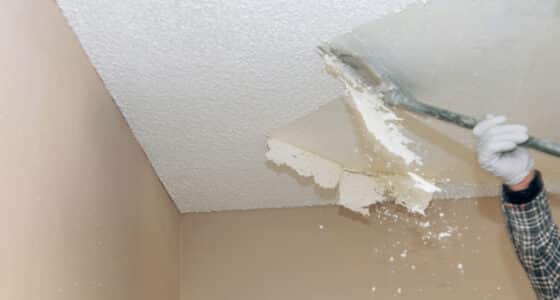Once considered decorative, decorative ceilings may or may not hide asbestos, the mineral that causes malignant mesothelioma and other serious illnesses. Whether you’ve just purchased a home or have been living with this decorating throwback for years, it’s important to understand the dangers it might pose to your family, how to determine whether it’s contaminated or not, and how to safely get rid of it if it does contain the toxic material.

What Is Asbestos and Why Is It Dangerous?
Asbestos was once highly valued for its ability to add strength, insulate, and resist heat and flame. However, asbestos has come to be known as a highly toxic mineral that can cause deadly illnesses when inhaled or ingested.
Archaeological evidence dates its use back to the Stone Age, and it has been found in the cloth used to wrap mummies, in pots, and cooking utensils dating back to 2400 B.C. The Ancient Greeks used it in cloths that they would then clean by setting them on fire. Even in those early times, it was noted that slaves who worked with the material often died young.[1]
In more modern times, asbestos use was ubiquitous. From the Industrial Revolution on, asbestos was used in industrial settings, in construction materials, and in personal and consumer goods.
It was inexpensive and readily available, and its characteristics made it so flexible and offered so many beneficial properties that its uses seemed limitless. Its popularity remained until it was confirmed to be carcinogenic in 1978.
Many had suspected a link between asbestos and cancer — in fact, the first cases of asbestosis and lung cancer attributable to asbestos exposure were diagnosed in 1935. The Library of Congress has had a book on its shelves that links asbestos and workplace illnesses since 1939.[2]
In 1973, the U.S. Environmental Protection Agency (EPA) banned spray-applied surfacing asbestos-containing material for fireproofing and insulating purposes. Many other asbestos uses were banned in the years that followed.[3]
The reason that asbestos was banned was because it was identified as the cause of malignant mesothelioma, asbestosis, asbestos-related lung cancer, and other serious illnesses.
Though the material is not dangerous when it is intact, when it is in a friable (rather than an encapsulated) form, it can fall apart and release fibers easily. When asbestos fibers are inhaled or ingested, they become embedded in the body’s tissues. Here, they can cause cell death or mutations that form into deadly tumors.
Before 1978, friable asbestos was used for many applications, including:[4]
- Insulation around pipes and boilers, and in attics and between walls
- Insulation around hot water pipes
- Decorative and acoustical plaster
- Cement sheets and asbestos cement
- Fire curtains and doors
- Caulking, putties, and joint compounds
- Adhesives, including flooring tile glue and even some brands of duct tape
- Wallboard, siding, roofing materials, and felt
- Vinyl floor tiles
- Other sprayed-on, asbestos-containing products
Though builders and tradesmen largely discontinued the use of asbestos-containing materials in the United States after 1978, legacy asbestos remains in some homes that were built before 1980.
While some is hidden in attics or behind walls in electrical wiring or insulation, the danger is in plain sight in homes with popcorn and textured ceilings.
Asbestos in Popcorn Ceilings
There’s a reason why people think popcorn ceilings give a room a dated look: they were common in homes built between 1945 and the 1980s. The EPA passed the Clean Air Act, which, among other things, outlawed the use of spray-applied asbestos-containing materials.[5]
This included popcorn ceilings, the textured material that builders used to mask imperfections, add to soundproofing, and improve fire resistance.
The association between popcorn ceilings, textured paints, and asbestos likely contributed to their having fallen out of favor. These products remain in many of the homes where it was originally installed.
This poses a problem for anybody considering a renovation, as disturbing asbestos popcorn ceilings can release fibers into the air. These fibers can lead to exposure through inhalation or ingestion.
How to Identify Asbestos in Popcorn Ceilings
If you have a popcorn ceiling or a ceiling that’s been treated with textured paint and your home was built before the 1990s, there’s a very good chance that it contains asbestos.
Though there are sampling kits available at hardware and home improvement stores, experts say that the results these over-the-counter kits deliver are often unreliable.
The most accurate way to confirm the presence of asbestos in ceiling materials is to have it tested by a professional lab that will examine a sample that you or a professional will collect.[6]
If you choose to collect a sample on your own, asbestos abatement professionals offer the following guidance:[6]
- Follow the directions on the sample kit exactly.
- Wear a mask to avoid inhaling any dust.
- Make sure you protect your home by using a wet, soapy wipe to collect debris generated during the process, and if the floor is carpeted, lay a plastic sheet down to catch the dust and then carefully roll it up and throw it away.
- Place your sample in zip-lock bags and make sure they are completely sealed.
- Wash your hands thoroughly after handling the sample, taking care not to touch your face or clothes before doing so.
What to Do if Your Popcorn Ceiling Contains Asbestos
If your sample is positive and indicates that there is asbestos in your popcorn or textured paint ceiling, there are three options for eliminating the health risks that it poses.[6]
- Encasement – This involves covering the ceiling so it can’t produce toxic dust. Options include installing new ceiling panels or spraying the ceiling with vinyl paint.
- Encapsulation – This involves treating the ceiling materials with a special material that either creates a membrane over the ceiling or penetrates it and binds its components together so that it can’t deteriorate.
- Removal – This should be done by a trained and accredited asbestos abatement professional.
If you choose encasement or encapsulation, it is important to understand that the asbestos will still need to be addressed during future remodeling or renovations.
EPA Do’s and Don’ts for Homeowners Who Find Asbestos
If you do find that your popcorn ceiling contains asbestos, the following list of Do’s and Don’ts from the EPA may be helpful:[7]
- Do leave undamaged asbestos-containing materials alone.
- Do keep activities to a minimum in any areas having damaged material that may contain asbestos, including limiting access to any materials that may contain asbestos.
- Do take every precaution to avoid damaging asbestos-containing material.
- Do have removal and major repairs done by people trained and qualified in handling asbestos. It is highly recommended that sampling and minor repair also be done by a trained and accredited asbestos professional.
- Don’t dust, sweep, or vacuum debris that may contain asbestos.
- Don’t saw, sand, scrape, or drill holes in asbestos-containing materials.
- Don’t track material that could contain asbestos through the building. If you cannot avoid walking through the area, have it cleaned with a wet mop. If the material is from a damaged area or if a large area must be cleaned, call an asbestos professional.
The Risk Posed by Asbestos in Popcorn Ceilings
Mesothelioma, asbestosis, and asbestos-related lung cancer are generally occupational diseases. There are still risks for anyone exposed to asbestos fibers, including those exposed to popcorn ceilings that deteriorate over time or are damaged during home renovation projects, whether by homeowners or contractors who are not properly trained in asbestos management.
Sarah Dodge, the American Institute of Architects’ senior vice president of Advocacy and Relationships, warns that the risk of exposure to asbestos “is significant for anyone who disturbs the materials once installed, whether homeowners, contractors, facilities staff, or others.”[7]
In a case study published in the International Journal of Occupational and Environmental Health, researchers examined a case of lung cancer in a non-smoking individual exposed to asbestos from the acoustic ceilings in her apartment.
Noting that the victim had lived in her apartment building for several years, during which time the acoustic ceiling was affected by water damage that caused it to crumble, sag, and buckle, and that left white dust on flat surfaces and on her clothing.[8]
The dust coated the entire apartment and was spread throughout the apartment due to the landlord’s attempts at repair. This included sanding the ceiling and disposing of damaged material in the hall in front of her apartment without sealing. The cycle of damage and repair continued for eighteen years until she moved out.[8]
The study’s authors note that “Lung cancer and mesothelioma have been found to occur with low-dose exposure in multiple studies and among those whose only exposure was from asbestos-containing building materials. Asbestos in low concentrations does not necessarily correlate to a lower health risk.” The victim developed asbestosis symptoms before being diagnosed with lung cancer.[8]
Hiring an Asbestos Professional to Remove Your Popcorn Ceiling
If your popcorn ceiling or textured paint is contaminated with asbestos, removal is challenging. Though it is possible to do it yourself, it is a difficult and potentially dangerous job.
Though hiring a certified asbestos abatement contractor may be expensive, it’s important to choose one of these licensed professionals.[9]
Though every company has its own protocol, you can expect asbestos abatement professionals to:
- Remove furniture
- Seal windows and doors
- Turn off fans
- Close HVAC vents
- Cover light fixtures
- Wear protective gear
- Place asbestos material in sealed bags
- Provide or arrange disposal services for asbestos material
When it comes to the removal of asbestos-containing popcorn ceilings or paint, your safety is what’s most important. Hiring an experienced asbestos abatement professional is the best way to ensure the job has been done the right way.
Help If You’ve Been Diagnosed With an Asbestos-Related Disease
If you’ve been exposed to an asbestos-containing popcorn ceiling and have been diagnosed with mesothelioma or another asbestos-related disease, you may be eligible to file a lawsuit against the companies responsible for your exposure. To learn more about seeking compensation, contact a mesothelioma attorney.
References
- Morgan King. (n.d.). The History of Asbestos Production.
Retrieved from: https://www.morganking.co.uk/blogposts/the-history-of-asbestos-production/ - Mesothelioma Research Foundation of America. (n.d.). Asbestos History.
Retrieved from: https://mesorfa.org/exposure/history.php - U.S. Environmental Protection Agency. (2016, December 19). U.S. Federal Bans on Asbestos.
Retrieved from: https://19january2017snapshot.epa.gov/asbestos/us-federal-bans-asbestos_.html#regulatory - Gordon, L.K. (2022, August 6). Asbestos in the Home: How to Find It and What to Do. Realtor.com
Retrieved from: https://www.realtor.com/advice/home-improvement/asbestos-in-the-home/ - New Ceilings. (n.d.). How New EPA Regulations Affect Popcorn Removal.
Retrieved from: https://newceilings.com/new-epa-regulations-affect-popcorn-removal/ - Jones-Stohosky, L. (2021, March 12). When to Test for Asbestos in Popcorn Ceilings. JSE Labs.
Retrieved from: https://jselabs.com/blog/popcorn-ceiling-asbestos/ - U.S. Environmental Protection Agency. (2025, July 1). Protect Your Family from Exposures to Asbestos.
Retrieved from: https://www.epa.gov/asbestos/protect-your-family-exposures-asbestos - Dahlgren, J.G. and Talbott, P.J. (2016, April). Lung Cancer from Asbestos Textured Ceilings: A Case Study. Int. J. Occup. Environ. Health. 22(2), 175-78.
Retrieved from: https://pmc.ncbi.nlm.nih.gov/articles/PMC4984962/ - Southwest Clean Air Agency. (2007, December). Asbestos Removal Procedures for Home Owners.
Retrieved from: https://www.swcleanair.gov/docs/misc/asbestos_popcorn_ceiling.pdf

Terri Heimann Oppenheimer
WriterTerri Oppenheimer has been writing about mesothelioma and asbestos topics for over ten years. She has a degree in English from the College of William and Mary. Terri’s experience as the head writer of our Mesothelioma.net news blog gives her a wealth of knowledge which she brings to all Mesothelioma.net articles she authors.

Dave Foster
Page EditorDave has been a mesothelioma Patient Advocate for over 10 years. He consistently attends all major national and international mesothelioma meetings. In doing so, he is able to stay on top of the latest treatments, clinical trials, and research results. He also personally meets with mesothelioma patients and their families and connects them with the best medical specialists and legal representatives available.


